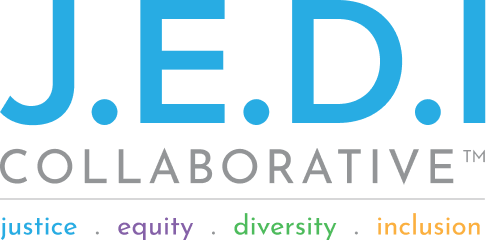We commit to fostering a company CULTURE where the voices, needs and experiences of those who have been marginalized are centered.
Expand to view each of the Culture Commitments including strategies, success indicators, resources, and solutions partners:
Promote inclusive and equitable workplace policies/practices
Success looks like:
Increased retention of women and people of color in the industry (lower turnover and greater tenure)
Strategies may include:
- Support employee resource/affinity groups for women staff, LGBTQ staff and staff of color
- Ensure the physical work spaces are not only ADA compliant but inclusive in décor and lighting
- Establish gender neutral bathrooms and changing rooms
- Ensure all locations have private rooms for parents to pump or breastfeed
- Establish policies that promote disclosure of employee pronouns in emails and meetings
- Create inclusive office attire policies that don’t require employees to adhere to unreasonable standards of purported respectability
- Support secular themes for events and celebrations (create a rubric for event organizers to avoid cultural appropriation such as Taco Tuesday or Hawaiian themed party with leis and religious focus such as Christmas and Easter)
- Avoid cultural appropriation in décor (e.g., prayer flags, totem poles, images that exoticize people from other countries).
- Provide flexible work hours and locations policies (job sharing, flex time, part time, telecommuting, shift sharing)
- Institute flexible holiday calendars that allow staff to observe their own high holidays irrespective of religion
Resources:
- Catalyst Resources on ERGs
- Why People of Color Need Spaces Without White People
- Solution for the “Confusing” Gender Neutral Toilet Sign Issue
- 6 Ways to Foster Belonging in the Workplace
- Women’s Earth Alliance (WEA)
- Gender Identity, Gender Pronouns and Definitions
- Resources on Pronouns
- CEO Blueprint for Racial Equity
Institute equitable and inclusive compensation practices and benefits for staff
Success looks like:
Greater employee satisfaction and no disparities in engagement and satisfaction across race or gender (as measured by a culture/climate audit)
Strategies may include:
- Conduct compensation equity audit across at least race and gender
- Ensure compensation transparency across employee base (including publishing salary ranges for each employee level/title)
- Increase the lowest wages to $15 per hour
- Provide healthcare and 401K benefits to part time workers
- Provide financial services support to workers (low interest and interest fee loans, financial management/coaching, banking support, tax preparation support, etc.)
- Institute parental leave policies for all genders
- Provide parental leave for all workers (including hourly)
- Provide adoption leave for all workers (including hourly)
- Create robust dependent care policies
- Consider becoming a worker-owned company
Resources:
Solutions Partners:
Interrupt and mitigate the internal, interpersonal, institutional, and ideological biases in the natural products industry
Success looks like:
Greater employee satisfaction and no disparities in experiencing microaggressions across race, gender, sexual orientation, or other anonymously disclosed identities (as measured by a culture assessment described below)
Strategies may include:
- Administer a culture assessment/survey that gauges staff experiences and measures inclusivity across identity.
- Create a J.E.D.I values statement and company culture expectations
- Provide ongoing training to staff on building awareness, unpacking, mitigating, and interrupting their own implicit biases, especially as it relates to race/ethnicity, gender, class, education, and body size.
- Create and disseminate information on the history of the natural products industry juxtaposed with social history to build greater awareness of historical forces of oppression
- Create a resources library of books, podcasts, articles, blogs, vlogs, and more that support the industry in its learning
- Create a cohort program where learners engage in a learning continuum on JEDI and take learnings back to their companies
- Incorporate JEDI into performance reviews to hold staff accountable
- Support both affinity and accountability spaces
Resources:
- Implicit Association Test
- Microaggression/Bias Virtual Reality Simulations
- The Avarna Group Trainings and Culture Assessment
- The Avarna Group J.E.D.I webinars
- TMI Consulting Culture Assessment
- SkinisSkin Stereotype Awareness Resources
- Racial Identity Mode from Construct The Present
- Construct The Present
- Caucus and Affinity Groups
- Equity means supporting single identity spaces
- Tips for Creating Effective White Caucus Groups
- Challenging White Supremacy Workshop Online
- 21-Day Racial Equity Challenge in Food Systems:
- Essay on Sizeism in the Food Industry
- Below the Green Line Theory of Transformation by Margret Wheatly etc.
- A Guide to Discussing Identity, Power and Privilege
Promote and elevate women and people of color within the industry
Success looks like:
Greater gender and racial/ethnic diversity in senior level positions and leadership within the industry (directors and C suite)
Strategies may include:
- Sponsor, coach, and mentor staff with marginalized identities
- Mitigate bias in staff evaluations and promotions
- Implement 360 degree feedback to mitigate bias in staff evaluations
Resources:
Recruit and hire a more diverse workforce that represents the communities we aim to engage
Success looks like:
A year-upon-year increase in gender and racial diversity of new hires within the industry (from the baseline determined by the 2020 industry survey)
Strategies may include:
- Post job descriptions on sites other than Indeed and Idealist.
- Ensure hiring decisions are made on teams
- Mark out names and previous employers when screening resumes
- Hire for values fit not culture fit
- Craft job descriptions intentionally to attract broader talent
- Use a rubric during screening and interviews
- Recruit at non traditional universities – Community Colleges, Hispanic Association of College & Universities (HACUs) & Historically Black Colleges & Universities (HBCU), Tribal Colleges etc.
- Support bridge or pathways programs for people of color who may be interested in careers in the industry
Resources:
- Bias Interrupters Toolkits
- The Avarna Group Hiring Toolkit
- Job Description Gender Decoder
- Culture Fit v. Values Fit
- A TOOLKIT FOR RECRUITING AND HIRING A MORE DIVERSE WORKFORCE
- Equity, Diversity and Inclusion in Recruitment, Hiring and Retention
- Creative Alignments Tips for a Diverse Hiring Process
- Recruitment and Retention Toolkit
- A Four-Step Reference Guide to Recruiting, Hiring, and Retaining Employees with Disabilities
- AIRS Certification
- National Black MBA Association
- National Association of Black Accountants
- Association of Latino Professionals For America
- The Black Perspective
Promote diversity on boards and inclusive board practices
Success looks like:
A year-upon-year increase in gender and racial diversity on industry boards (from the baseline determined by the 2020 industry survey)
Strategies may include:
- Create a board composition matrix to identify gaps in representation of women and POC
- Create paid advisory positions for women and POC as a pathway to board service
- Reach out to professional networks that support single identities to find new board members
- Include requirements for women and people of color on every candidate slate
- Ensure you recruit people with marginalized identities in clusters (avoid having the “token” woman or person of color)
- Include J.E.D.I topics on all board meeting agendas
- Ensure board members with marginalized identities (such as women and POC) can meaningfully participate in meetings through the process of amplification, timing board member input to ensure those with dominant voices don’t take up most of the air time, and ensuring each board member is given the same amount of time to provide input during key discussions and decisions.
- Train boards on mitigating bias on boards and role modeling J.E.D.I leadership
Resources:
- Women on Boards
- The Board List
- Athena Alliance
- Catalyst Women on Board
- Professional Networks(Latino Organizations)
- Professional Networks(African Organizations)
- The Executive Leadership Council
- The 50 Most Powerful Latinas in Business
- 2020 MOST INFLUENTIAL BLACK EXECUTIVES IN CORPORATE AMERICA
- Top Latino Executives in Corporate America
- The Board Challenge
Promote J.E.D.I in funding and investors
Success looks like:
Your investors and investment opportunities reflect and support your JEDI work
Strategies may include:
- Seek socially conscious investors and funders who value J.E.D.I
- Seek capital from women and POC investors at all stages and train investors to understand biases implicit in funding practices (including angel investors, venture capitalists, and growth equity funders)
- Create investment strategies within your company (i.e. 401Ks) that support your J.E.D.I values
Resources:
Solutions Partners:
Take public policy action related to Culture work
Success looks like:
Advocating for policies that address: protections for workers related to benefits, providing a livable wage, pay equity issues, worker safety, workplace harassment issues and increasing the diversity on boards.
Strategies may include:
- Advocate the protection and expansion of Family and Medical Leave Act to ensure care-takers can take the time off from work to care for those in need.
- Advocate for raising the minimum wage to provide a fair and liveable wage for workers in the US



